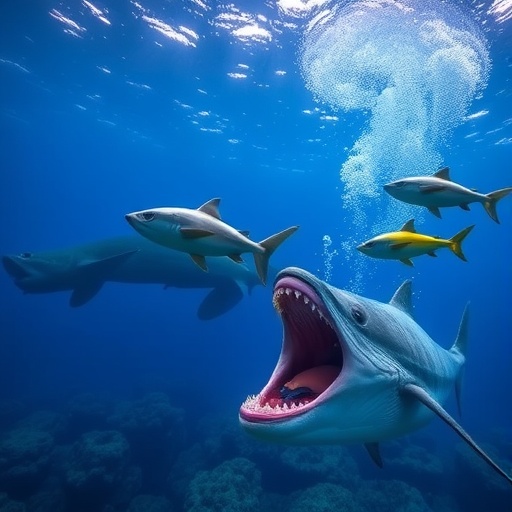The vast and complex marine ecosystems off the coast of California play host to a diverse array of species, many of which rely heavily on the availability and quality of their prey. Recent research conducted by University of California San Diego scientists has illuminated a surprising dimension of predator-prey dynamics that challenges longstanding assumptions within ecological models. Their study reveals that the energy content of prey varies significantly even within a single species, dramatically shifting our understanding of how marine predators fulfill their nutritional needs.
During the catastrophic marine heat wave of the mid-2010s, a period marked by intense ocean warming, starvation events became widespread among marine mammals and seabirds along the California Current Ecosystem. These phenomena spurred researchers to investigate not just the quantity but the quality of available prey species such as anchovies, sardines, and squid — staples of the California sea lion diet. Their findings, published in the Journal of Animal Ecology, reveal that individual prey animals can differ markedly in their energy density, the parameter that defines the caloric value available to predators.
Energy density represents the amount of energy stored in a given mass of prey, and it has traditionally been assumed constant within species across different environmental contexts. However, this research utilized bomb calorimetry — an analytical technique that measures the heat released from the combustion of prey tissues — to capture the true variation in energy content. The investigation uncovered that two fish of identical size and weight could carry dramatically different caloric values depending on environmental and physiological factors, such as regional nutrient availability and reproductive status.
This variation is not a trivial detail; it profoundly impacts the foraging requirements and strategies of marine predators. Lower-energy prey compel predators to consume significantly larger quantities in order to meet their metabolic demands. The research quantifies that in some instances, sea lions may need to consume tens of thousands more lower-quality prey to survive, a feat biologically and behaviorally implausible under natural conditions. This amplifies the risk of starvation and helps explain the observed mortality during environmental crises.
The study emphasizes that current bioenergetic models, which estimate predator consumption rates and population viability, often oversimplify assumptions by treating all prey of the same species as having identical energy values. Incorporating intraspecific variability into these models enhances their predictive accuracy and ecological relevance, especially under scenarios of environmental change where prey quality fluctuates alongside abundance.
One of the remarkable aspects of this research journey was the integration of community engagement through the Ocean Discovery Institute, involving local students from underserved neighborhoods in San Diego. This participatory approach not only facilitated extensive sample collection but also fostered scientific literacy and inspired upcoming generations to engage with oceanographic and ecological research.
The implications of these findings extend beyond sea lions or the California Current. The dynamic nature of prey quality is influenced by environmental factors such as ocean productivity, seasonal nutrient fluxes, and individual growth or reproductive investment, which collectively shape energy allocation within prey species. Understanding this complex variability is pivotal for ecosystem management, fisheries sustainability, and conservation strategies.
By revising the scientific lens through which marine food webs are analyzed, this work underscores the nuanced interdependence of predator and prey dynamics that dictate population health. As ocean conditions continue to evolve rapidly due to climate change, accounting for variability in prey nutritional content emerges as a critical component for forecasting ecological outcomes and guiding adaptive management practices.
Scientists Stephanie Nehasil and Carolyn Kurle stressed that acquiring accurate baseline data on prey composition is essential for refining ecosystem models. This data provides insights into subtle but consequential shifts in ecosystem structure that may otherwise be neglected, and thereby assists policymakers, conservationists, and fishery managers in making informed decisions.
The study also highlights the cascading consequences of disruptions such as the 2014 North Pacific marine heat wave. By curtailing nutrient upwelling, the event diminished the base of the food chain— zooplankton populations — which in turn compromised fish stock quality and availability. The subsequent trophic ripple effects manifested in widespread starvation and vulnerability across higher trophic levels, including marine mammals and seabirds.
This research serves as a timely reminder that sustainable ecosystem stewardship necessitates an appreciation for both quantitative and qualitative aspects of marine food resources. It challenges previously held assumptions and advances ecological knowledge by providing a more detailed and refined understanding of predator-prey relationships in marine environments.
In conclusion, acknowledging and quantifying intraspecific variability in prey energy content transforms our understanding of marine predation dynamics. Such knowledge not only enriches scientific theory but equips stakeholders with critical tools to anticipate and mitigate the multifaceted impacts of environmental change on oceanic life.
Subject of Research: Animals
Article Title: Intraspecific variation in prey quality affects the consumption rates of top predators
News Publication Date: 28-Oct-2025
Web References: http://dx.doi.org/10.1111/1365-2656.70155
Image Credits: Anthony Orr, NOAA Fisheries; NMFS permits 782-1812, 16087, 22678
Keywords: Marine life, Predation, Nutrition, Starvation, Marine mammals, Food webs, Marine ecosystems, Nutrients




